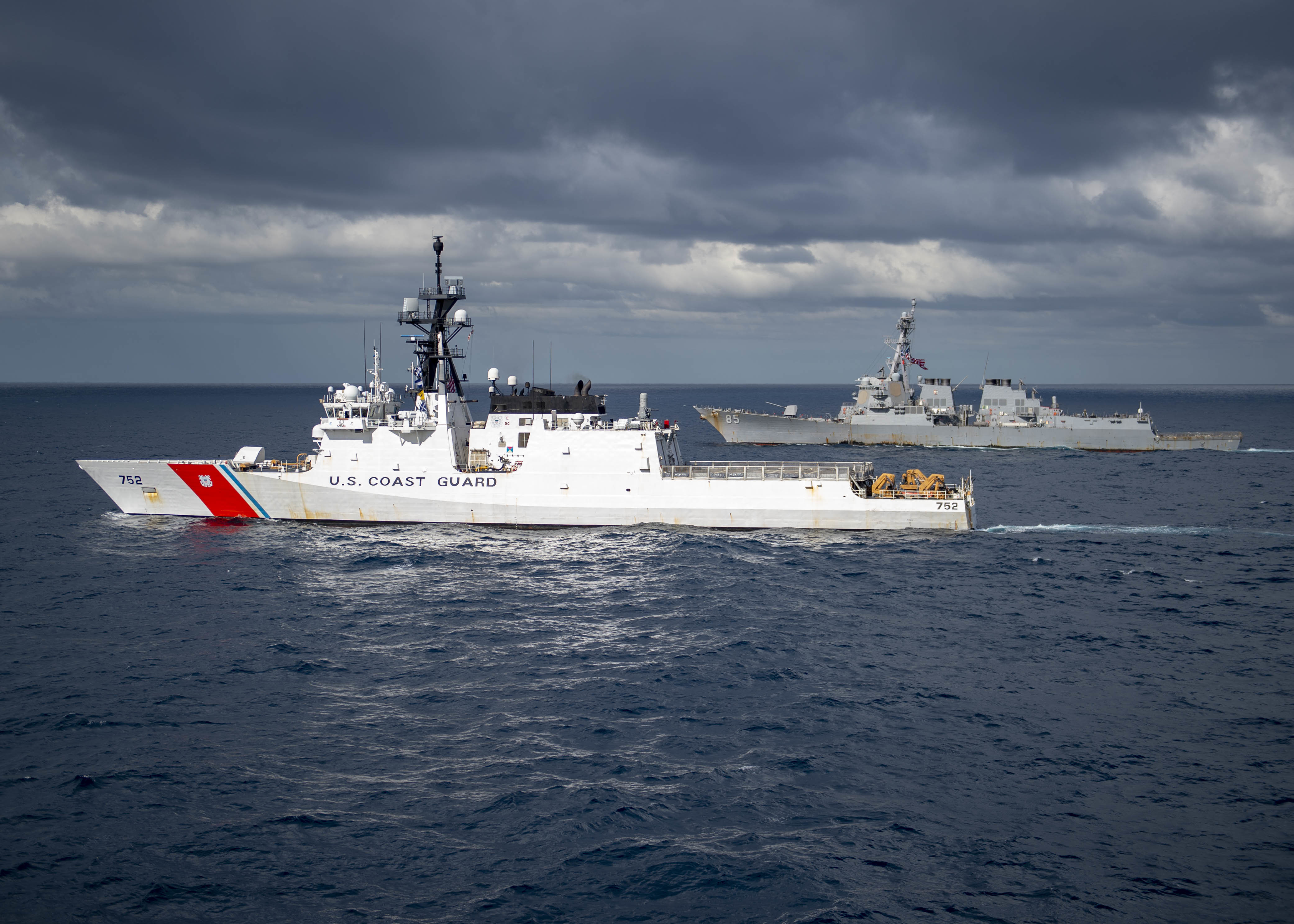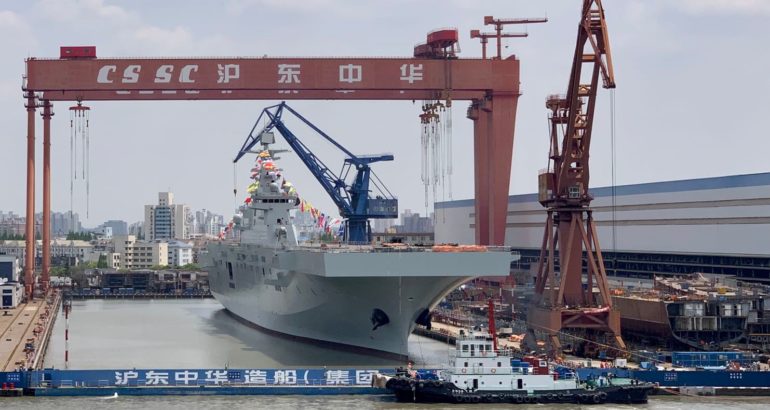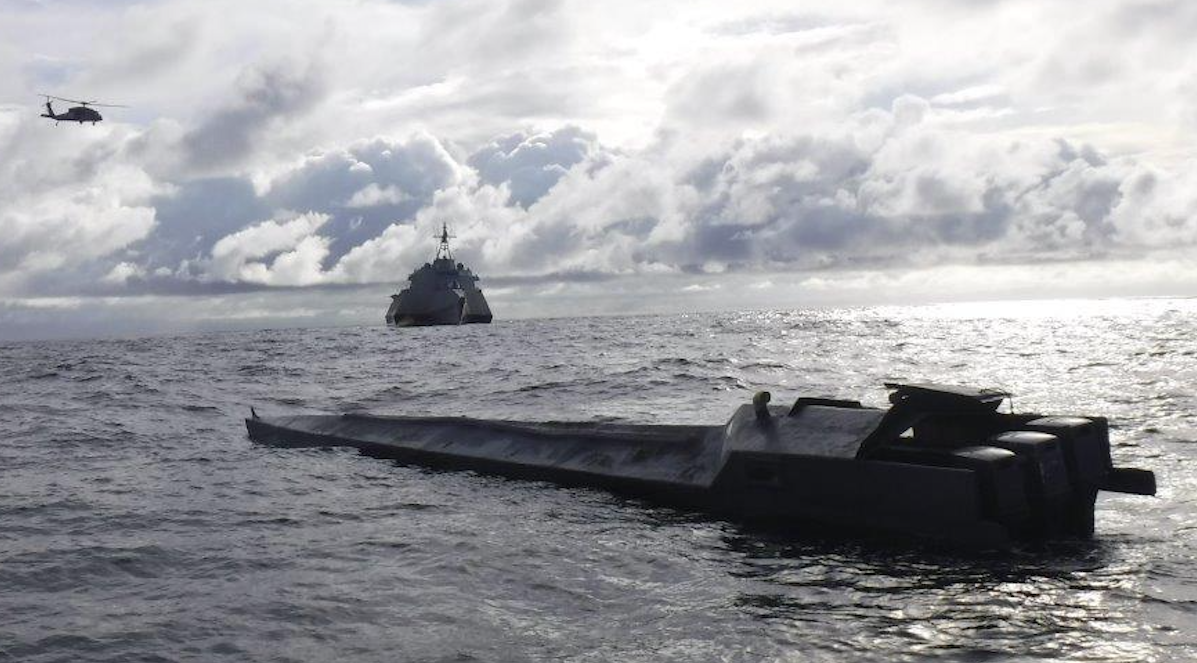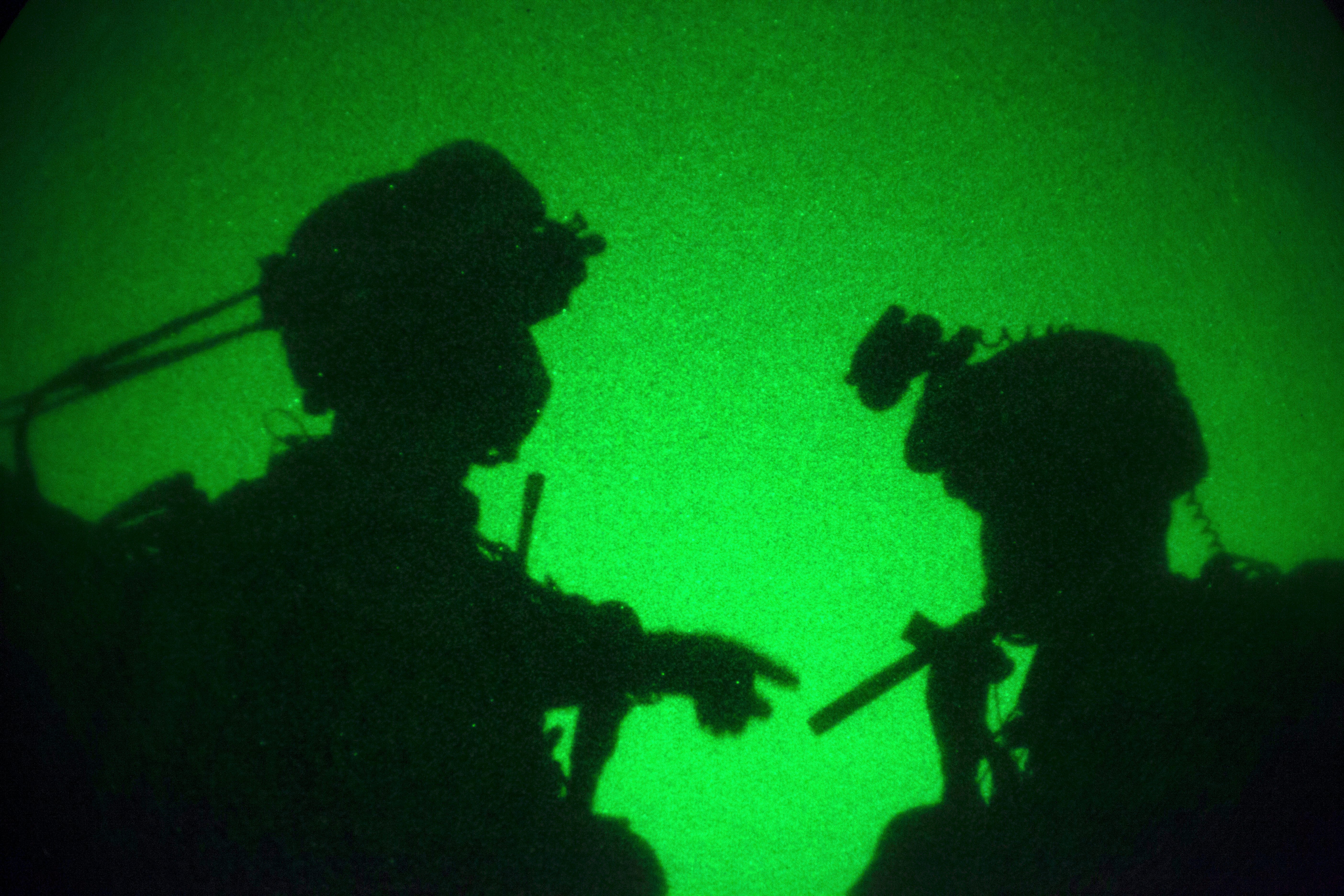
The Navy, Marine Corps and Coast Guard released their clearest argument yet for what they need to do to be prepared to take on China – not in a hypothetical future scenario, but in the day-to-day competition happening now on the seas.
The chief of naval operations and the commandants of the Marine Corps and Coast Guard signed a tri-service maritime strategy – Advantage at Sea; Prevailing with Integrated All-Domain Naval Power – that was released today and is the first of its kind since the 2015 Cooperative Strategy for 21st Century Seapower.
The document notes that the services need to work together today to make preparations for a high-end war with China – but equally importantly, they need a strategy and the right tools to counter the day-to-day competition, sometimes called gray-zone operations, that China is currently conducting. The strategy accuses China of attacking military and civilian cyber networks; fielding naval auxiliaries disguised as civilian vessels; militarizing disputed islands and rock formations in the South China Sea; building up strategic, space, cyber, electronic, and psychological warfare capabilities; and pressuring small countries economically to build up overseas logistics and basing infrastructure in strategic maritime locations – activities that have been ongoing for years but the services haven’t been well positioned to talk about or counter.
This new strategy looks at the entire continuum of competition, crisis and conflict and examines in detail how the three services can play a role in each phase and what new tools and concepts they’ll need to succeed.
The document begins by laying out the problem: “Advantage at Sea is a Tri-Service Maritime Strategy that focuses on China and Russia, the two most significant threats to this era of global peace and prosperity. We prioritize competition with China due to its growing economic and military strength, increasing aggressiveness, and demonstrated intent to dominate its regional waters and remake the international order in its favor. Until China chooses to act as a responsible stakeholder rather than brandish its power to further its authoritarian interests, it represents the most comprehensive threat to the United States, our allies, and all nations supporting a free and open system.”
“China has implemented a strategy and revisionist approach that aims at the heart of the United States’ maritime power. It seeks to corrode international maritime governance, deny access to traditional logistical hubs, inhibit freedom of the seas, control use of key chokepoints, deter our engagement in regional disputes, and displace the United States as the preferred partner in countries around the world,” it adds.

Noting that China’s navy is growing faster than the U.S.’s and could further expand faster in wartime due to greater manufacturing capacity than the United States – plus the fleet is focused on the Western Pacific, whereas the U.S. fleet has global responsibilities – the Navy, Marine Corps and Coast Guard lay out a new strategy that leverages each service’s unique advantages grows overall capacity in a cost-minded way.
“Integrated naval forces are uniquely suited for operations across the competition continuum. The Coast Guard’s mission profile makes it the preferred maritime security partner for many nations vulnerable to coercion. Integrating its unique authorities—law enforcement, fisheries protection, marine safety, and maritime security—with Navy and Marine Corps capabilities expands the options we provide to joint force commanders for cooperation and competition. In conflict, Navy-Marine Corps integration expands our ability to control the seas, as we combine distributed fleet operations and mobile, expeditionary formations with sea control and sea denial capabilities. These operations are guided by Naval Service concepts—Distributed Maritime Operations, Littoral Operations in a Contested Environment, and Expeditionary Advanced Base Operations—that combine the effects of sea-based and land-based fires, enabling our forces to mass combat power at times and places of our choosing. Closer integration allows our forces to distribute more broadly and increase our operational unpredictability across the competition continuum by varying our timing, location, domain, forces, and activities.”
Further complicating the operating picture is the notion that, “In strategic competition, interactions between our forces and those of our competitors may occur at varying levels of intensity, in different locations, and in multiple domains simultaneously. In the following three sections—day-to-day competition, crisis, and conflict— we illustrate how our naval forces operate seamlessly across the competition continuum” while leveraging five main lines of effort.
- Advance global maritime security and governance. We will operate with allies, partners, other U.S. agencies, and multinational groups to maintain a free and open maritime environment, and uphold the norms underpinning our shared security and prosperity.
- Strengthen alliances and partnerships. We will maintain and expand our large and diverse network of allies and partners. Acting with unity of effort, like-minded-nations generate enormous power to modify behavior in the maritime domain. Allies and partners must be ready and willing to bring capability and capacity to operations across the competition continuum.
- Confront and expose malign behavior. Together with whole-of-government partners, we will deny the obscurity that our rivals exploit, holding them accountable to the same standards by which others abide. Exposing and attributing malign behavior imposes reputational costs, diminishes the effectiveness of propaganda, and galvanizes international resistance.
- Expand information and decision advantage. We will maintain superiority in coordinating, distributing, and maneuvering our forces. We will sense, decide, and act more quickly and effectively than our adversaries. Maintaining decision advantage removes adversary leaders’ sense of control, inducing doubt and increased caution in crisis and conflict.
- Deploy and sustain combat-credible forces. Forward deployed, combat-credible forces enable all lines of effort. We will deter potential adversaries from escalating into conflict by making that fight unwinnable for them. Should our adversaries choose the path of war, naval and joint forces will defeat adversary forces and impose global costs by leveraging our wartime operational concepts.

Starting with competition – which is already happening at sea today with China – the strategy says, “Together with international and whole-of-government efforts, the Naval Service will detect and document our rivals’ actions that violate international law, steal resources, and infringe upon the sovereignty of other nations. We will provide evidence of malign activities to U.S. and international officials to expose this behavior and increase the reputational costs for aggressors. Forward naval forces, leveraging our complementary law-enforcement authorities and military capabilities, will stand ready to disrupt malign activities through assertive operations. Our expanded efforts will refute the false narratives of our rivals and demonstrate the United States’ commitment to protecting the rules-based order.”
To prepare for a crisis, “the Naval Service offers flexible options to respond to crises, manage escalation, and preserve decision space for national leaders. Because naval forces are globally maneuverable and persistently operate forward, we are often already on-scene at the onset of a crisis.”
“Operating our naval forces far forward—in harm’s way and in contested environments— raises the risks for rivals considering the path of escalation and prevents crisis from escalating into war. Navy and Marine Corps forces demonstrate visible combat readiness, support deterrence, and missile defense. Coast Guard forces provide additional tools for crisis management through capabilities that can de-escalate maritime standoffs nonlethally,” it continues.
To prepare for all-out conflict, the strategy largely aligns with the operational concepts and related shipbuilding plans the Navy has been working on over the past few years. The Navy will achieve a fleet optimized for Distributed Maritime Operations, where a large number of small and unmanned ships will be spread out across the vast Pacific, with larger aircraft carriers, amphibious ships and destroyers armed with long-range weapons and aircraft to contribute to the fight. The Marine Corps will be optimized for its Littoral Operations in a Contested Environment and its Expeditionary Advance Base Operations concepts, where small groups of Marines will be able to maneuver around the battlespace, providing forward refueling stations, temporary missile-launching sites, intelligence-gathering posts and more. And the Coast Guard, which previously hadn’t talked about its role in this future DMO/EABO fight, would contribute with its niche capabilities, such as interdiction teams that could disrupt the flow of logistics to the enemy.
The strategy outlines what a possible conflict could look like in greater detail than the services have previously discussed:
“Controlling the seas enables the Naval Service to project power in support of Joint Force efforts and protect joint and allied forces surging to conflict theaters. Where adversaries must cross open water, sea denial robs them of the initiative, impedes a fait accompli, and prevents them from achieving their objectives. We control or deny the seas by destroying an adversary’s fleet, containing it in areas that prevent meaningful operations, prohibiting it from leaving port, or by controlling sea lines of communication. In collaboration with allies and partners, we will be capable of controlling critical choke points, enabling us to safeguard joint forces flowing into theater and to impose military and economic costs on our adversaries,” it reads.
“Our combat operations will support, and be supported by, the Joint Force. Navy, Marine Corps, and Air Force aircraft will sustain dominance of the skies, supported by joint aerial refueling assets. Bombers and fighters will mass overwhelming anti-surface and land-attack fires. Marine Corps expeditionary forces ashore will support domain awareness, provide forward arming and refueling points, and deny adversaries the use of key maritime terrain. Rapidly deployable Coast Guard cutters, Port Security Units, and Advanced Interdiction Teams will provide specialized capabilities, augmenting operations in theater. Joint long-range precision fires will hold high-value adversary targets at risk, allowing U.S. and allied forces to focus on destroying the adversary’s fleet. Joint theater logistics will sustain and enable a high operational tempo in combat. Joint cyber and space effects will support all of these operations.”

“Allies and partners add capability, capacity, and legitimacy in combat operations. Leveraging our interoperable C2 networks, allies and partners provide all-domain fires to help establish sea control and project power. They interdict adversary war materials and commerce; provide access, basing, and overflight; and deliver additional critical capabilities, such as intelligence and logistics support. Allies and partners will also play a crucial role in deterring opportunistic aggression in additional theaters, as well as maintaining maritime governance and exposing malign behavior.”
Many of the acquisition needs to support this vision are already well established, including long-range anti-ship missiles for Marines; “maritime domain awareness technologies to find, fix, track, and target adversary forces;” Virginia-class attack submarines and improved undersea warfare capabilities such as a bolstered Integrated Undersea Surveillance System infrastructure and offensive mines; longer-range aircraft to expand the lethality and survivability of the carrier air wing; and a more flexible and resilient – and larger – network of logistics ships.
The strategy notes that, in trying to find the funds to pay for fleets that can fulfill this vision, the services must prioritize sea control and sea denial over other missions; must focus on platforms and formations that can quickly transition from day-to-day competition to conflict if needed; and must ensure the three services remain interoperable and netted together to share common operating pictures, targeting data and communications.
Navy Secretary Kenneth Braithwaite, in a preface to the strategy, wrote that “This strategy details the direction our Service Chiefs have designed together. It is a strong signal of support for our personnel, our allies, and our partners—and a cautionary warning for any would-be adversaries. We are and will always be one force—Semper Fortis, Semper Fidelis, Semper Paratus—always strong, always faithful, and always ready to protect and defend the United States of America, around the clock and around the world.”





